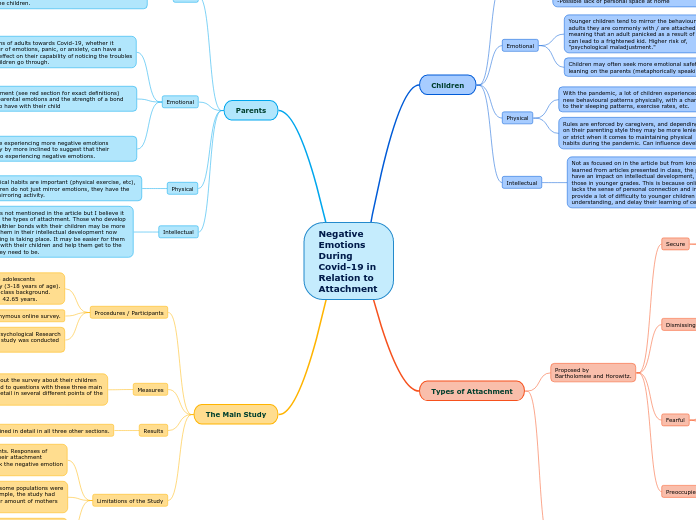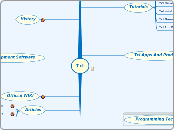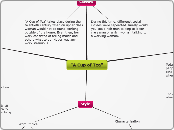Negative Emotions During Covid-19 in Relation to Attachment
The Main Study
Limitations of the Study
In the greater specifics of the study, researchers
only added in three items that were used to evaluate
the negative emotions of the parents filling out the study.
The researchers believe more focus should have been
placed on this.
The article indicates that, "some populations were
over-represented." For example, the study had
answers from a much larger amount of mothers
than fathers.
Data was only reported by the parents. Responses of
children could provide insight into their attachment
styles first-hand and what they think the negative emotion
correlation or pattern is.
Results
Explained in detail in all three other sections.
Measures
Parents were asked to fill out the survey about their children and were asked to respond to questions with these three main themes (all described in detail in several different points of the mind map).
The negative emotions they
perceive their children to have.
Their own negative emotions.
Their style of attachment.
Procedures / Participants
The Ethical Committee for Psychological Research
at the university where this study was conducted
approved it.
Format: anonymous online survey.
Participant count: 838 adolescents
and children from Italy (3-18 years of age).
Most families: middle-class background.
Average parental age: 42.65 years.
Parents
This subsection is not mentioned in the article but I believe it
can still relate to the types of attachment. Those who develop stronger and healthier bonds with their children may be more inclined to help them in their intellectual development now that online learning is taking place. It may be easier for them to communicate with their children and help them get to the level at which they need to be.
Parental physical habits are important (physical exercise, etc), because children do not just mirror emotions, they have the potential of mirroring activity.
Parents who are experiencing more negative emotions themselves may by more inclined to suggest that their children are also experiencing negative emotions.
Inquiry: is this projection of one's feelings onto the child
in the assumption that everyone goes through the same feelings, or is parental behaviour truly influencing their children to experience more negative thoughts? [See 'Fearful Type of Attachment subsection].
Types of attachment (see red section for exact definitions)
also influence parental emotions and the strength of a bond they perceive to have with their child
This can issues a chain reaction:
1) A parent displays one of the three insecure attachment styles, causing a child to develop a less healthy bond with them.
2)Parent potentially feels like they are not close with the child or that the child is a disappointment to them, influencing their own emotional well-being.
Reactions of adults towards Covid-19, whether it
be a blur of emotions, panic, or anxiety, can have a
drastic effect on their capability of noticing the troubles
their children go through.
Boundaries between work and family became more
arbitrary as many moved online. The only people the parents
see are the children.
According to a 2020 survey filled by parents on the emotional
consequences of social isolation on their children (aged 3-18, many said that the most dramatic changing factors were:
-Restlessness
-Stress
-Distraction
(This can fit under both emotional and social but was placed
in this section because it is in direct relation to social isolation effects).
Types of Attachment
Plays a key and essential role in the moderation
of parent-child relationships, especially during
stressful and global events such as the Covid-19
pandemic.
Proposed by
Bartholomew and Horowitz.
Preoccupied
Parents engaging in this style may lack goals
for self expression.
-Children are routinely ignored or put
at the bottom of the parent's priorities:
can develop higher anxiety, insecurity,
and avoidance levels.
Fearful
Parents may pick up more negative emotions from
children due to their own reactions.
Parents engaging in this style may be more
hesitant to trust others.
Can develop higher anxiety, insecurity,
and avoidance levels.
Dismissing
Parents may perceive less negative emotions from
children simply because they do not display
as many emotions either so it may be difficult for them
to pick up on.
Children may develop a higher degree
of resilience.
-Can develop higher anxiety, insecurity,
and avoidance levels.
Parents engaging in this style may be less
able to express their emotions.
Secure
Less conflicts with parents, less anxiety.
-Greater problem solving skills +
emotional control.
Children
Intellectual
Not as focused on in the article but from knowledge
learned from articles presented in class, the pandemic can have an impact on intellectual development, especially for those in younger grades. This is because online learning that
lacks the sense of personal connection and instruction can provide a lot of difficulty to younger children in focus or understanding, and delay their learning of certain materials.
Physical
Rules are enforced by caregivers, and depending
on their parenting style they may be more lenient
or strict when it comes to maintaining physical
habits during the pandemic. Can influence development.
With the pandemic, a lot of children experienced
new behavioural patterns physically, with a change
to their sleeping patterns, exercise rates, etc.
Emotional
Children may often seek more emotional safety by
leaning on the parents (metaphorically speaking).
Younger children tend to mirror the behaviour of
adults they are commonly with / are attached to,
meaning that an adult panicked as a result of Covid
can lead to a frightened kid. Higher risk of,
"psychological maladjustment."
Social
The following social factors can also relate to the emotional
sector in that the recent lack of them can contribute
to a multitude of emotional struggles:
-Lack of general social and public interaction
-Not seeing friends and the extended family
-Possible lack of personal space at home









